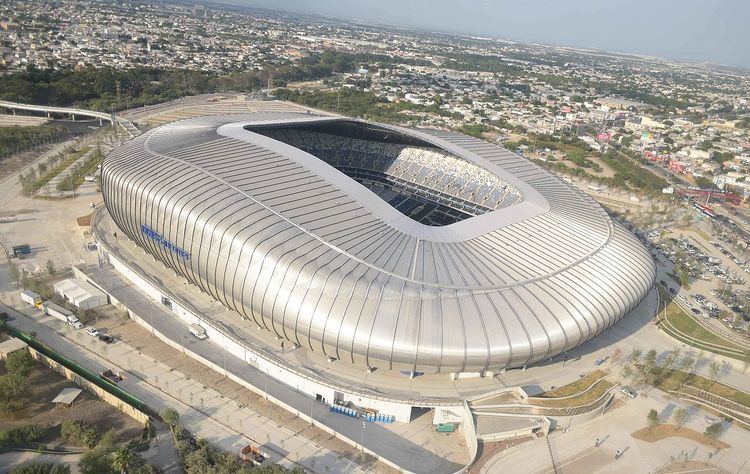Operator FEMSA Surface Grass Construction cost US$200 million Opened 2 August 2015 Owner FEMSA | Field size 265x223 Built 2011–2015 Capacity 53,500 Phone +52 81 8127 1500 | |
 | ||
Location Guadalupe, Nuevo León, Mexico Address Pablo Livas 2011, La Pastora, 67140 Guadalupe, NL, Mexico Similar Estadio Universitario, Estadio Chivas, Estadio Tecnológico, Estadio Cuauhtémoc, Estadio Corona | ||
se ilumina el ambiente estadio bbva bancomer la casa de los rayados
The Estadio BBVA Bancomer (El Gigante de Acero) is a stadium developed by FEMSA and C.F. Monterrey in Guadalupe, Greater Monterrey. The stadium replaced the Estadio Tecnológico as the home of Monterrey, ending 63 years of residency at that stadium. It was inaugurated on 2 August 2015 with the eighth edition of the Eusébio Cup, where Monterrey defeated Benfica 3–0.
Contents
- se ilumina el ambiente estadio bbva bancomer la casa de los rayados
- El estadio bbva bancomer la sede de la gran final
- Design
- Permeable area
- References
The project was met with much controversy, stemming from the multiple accusations of the construction as an apparent impediment to the wildlife growth on a local scale.
El estadio bbva bancomer la sede de la gran final
Design
The Monterrey Stadium is the most recent generation venue responsibly planned and integrated into its surroundings by its architectural design, created by one of the firms that have developed more stadiums than any firm in the world: Populous, and VFO Architects, one of the most experienced companies in sporting venues in Mexico.
The Stadium currently has a capacity of 52,237 people, the fourth largest in Mexico. It has an authentic grass surface, suites, a club-themed Restaurant, a club lounge, and high-end interior and exterior design. The inclination of the grandstand is 34 degrees and with the minimum distance allowed by FIFA to provide unsurpassed closeness to the action.
Permeable area
More than a third of the total land area will be green areas. This proportion exceeds the current regulations. These green areas will be used to filter rainwater, which will contribute to the recharge of aquifers. Parking lots will be evenly distributed around the stadium, including wooded areas to achieve a future integration with the Ecological Park. These areas will be divided into zones, which are integrated into the landscape and topography. The northern boundary to the Rio La Silla is a wooded trail area that will connect the Stadium with the New Ecological Park. This ecological park and parking will be green areas, with a landscape design that blends with the surrounding environment, with only trees and plants of the region to facilitate preservation and adaptation to the environment. The surface consists of grass supported and reinforced with a high strength plastic system called "Grasspave.".
